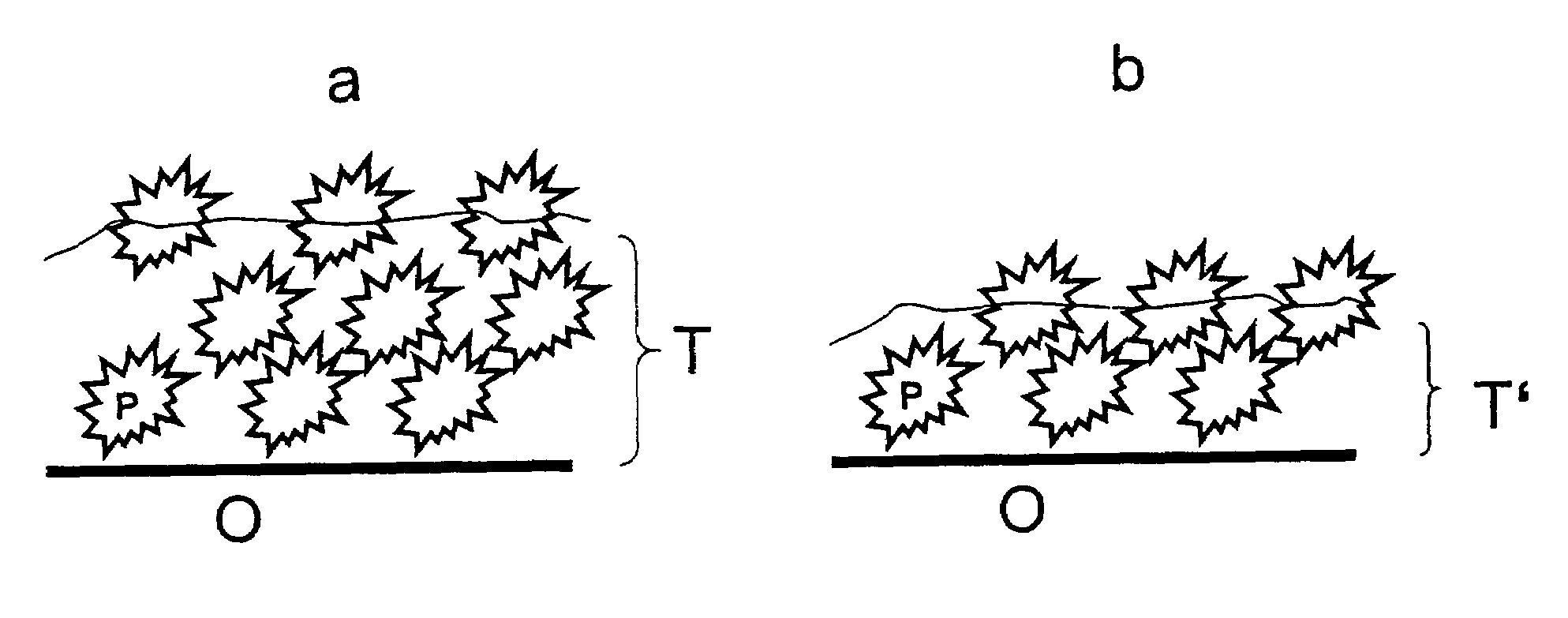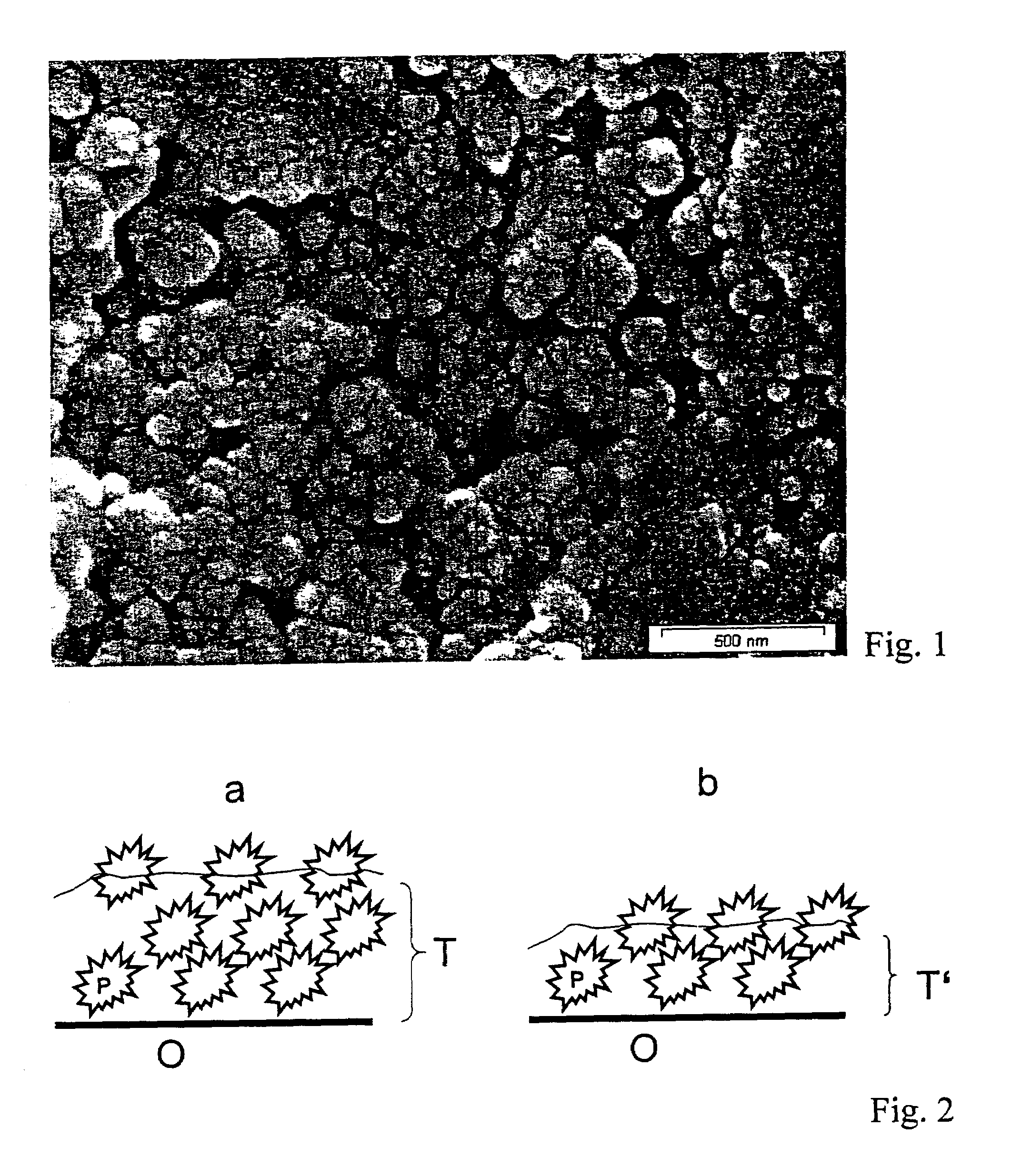Surfaces rendered self-cleaning by hydrophobic structures and a process for their production
a technology of hydrophobic structures and surface cleaning, applied in the direction of biocides, paints, roads, etc., can solve the problems of reducing surface energy, bringing about any noticeable reduction in surface energy, poor wetting, etc., and achieves high mechanical stability and simple process
- Summary
- Abstract
- Description
- Claims
- Application Information
AI Technical Summary
Benefits of technology
Problems solved by technology
Method used
Image
Examples
example 1
[0069]20% by weight of methyl methacrylate, 20% by weight of pentaerythritol tetraacrylate, and 60% by weight of hexanediol dimethacrylate were mixed with one another. Based on this mixture, 14% by weight of Plex 4092 F®, an acrylic copolymer from Rönhm GmbH, and 2% by weight of UV curing agent Darokur 1173® were added, and the mixture was stirred for at least 60 min. 8.45% by weight of hydrophobicized fumed silica, Aerosil VPR 411® (Degussa AG) were added to this mixture made from binder. with vigorous stirring, and stirring was continued until the particles had been completely and thoroughly mixed with the binder and had been completely wetted by the binder.
[0070]This mixture made from binder and particles was applied at a thickness of 50 μm as carrier to a PMMA sheet of thickness 2 mm. Initial drying of the layer was carried out for 5 min. The particles then sprayed on by means of an electrostatic spray gun were hydrophobicized fumed silica, Aerosil VPR 411® (Degussa AG). After 3...
example 2
[0071]The experiment of Example 1 is repeated, but Aerosil R 8200® (Degussa AG), which has a BET surface area of 200 ±25 m2 / g, is used instead of Aerosil VPR 411®. The assessment of the surface is +++.
example 3
[0072]10% by weight (based on the total weight of the surface coating mixture) of 2-(N-ethylperfluorooctanesulfonamido)ethyl acrylate was also added to the surface coating of Example 1, which had previously been mixed with the UV curing agent. This mixture, too, was again stirred for at least 60 min. This mixture was applied at a thickness of 50 μm as carrier to a PMMA sheet of thickness 2 mm. Initial drying of the layer was carried out for 5 min. The particles then applied by means of an electrostatic spray gun were hydrophobicized fumed silica, Aerosil VPR 411® (Degussa AG). After 3 min, the carrier was cured under nitrogen at a wavelength of 308 nm. Once the carrier had been cured, excess Aerosil VPR 411® was removed by brushing. Initial characterization of the surfaces was carried out visually and recorded as +++, meaning that there is almost complete formation of water droplets. The roll-off angle was 0.5°.
PUM
| Property | Measurement | Unit |
|---|---|---|
| height | aaaaa | aaaaa |
| height | aaaaa | aaaaa |
| size | aaaaa | aaaaa |
Abstract
Description
Claims
Application Information
 Login to View More
Login to View More - R&D
- Intellectual Property
- Life Sciences
- Materials
- Tech Scout
- Unparalleled Data Quality
- Higher Quality Content
- 60% Fewer Hallucinations
Browse by: Latest US Patents, China's latest patents, Technical Efficacy Thesaurus, Application Domain, Technology Topic, Popular Technical Reports.
© 2025 PatSnap. All rights reserved.Legal|Privacy policy|Modern Slavery Act Transparency Statement|Sitemap|About US| Contact US: help@patsnap.com


